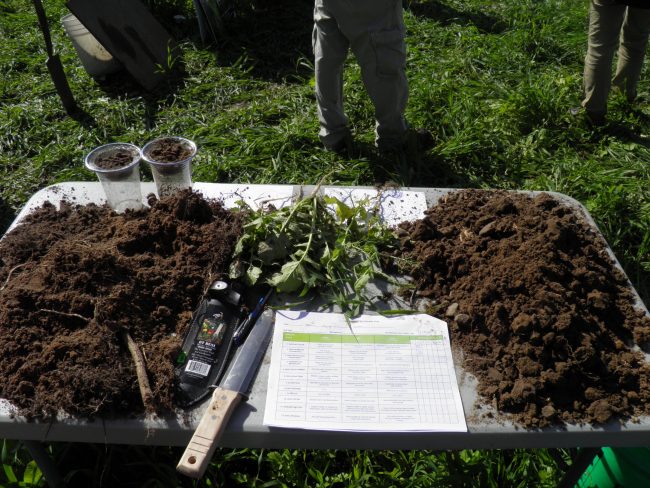Home » Natural Resources » Shell Lake-Yellow River Farmer-Led Watershed Council » Soil Health
Soil Health

What is it?
Soil health, also referred to as soil quality, is defined as the continued capacity of soil to function as a vital living ecosystem that sustains plants, animals, and humans. Only “living” things can have health, so viewing soil as a living ecosystem reflects a fundamental shift in the way we care for our nation’s soils. Soil isn’t an inert growing medium, but rather is teaming with billions of bacteria, fungi, and other microbes that are the foundation of an elegant symbiotic ecosystem. Soil is an ecosystem that can be managed to provide nutrients for plant growth, absorb and hold rainwater for use during dryer periods, filter and buffer potential pollutants from leaving our fields, serve as a firm foundation for agricultural activities, and provide habitat for soil microbes to flourish and diversify to keep the ecosystem running smoothly.
Key Soil Health Management Principles:
Minimize disturbance
Soil disturbance can be the result of physical, chemical or biological activities. Physical soil disturbance, such as tillage, results in bare and/or compacted soil that is destructive and disruptive to soil microbes, and it creates a hostile environment for them to live. Misapplication of farm inputs can disrupt the symbiotic relationships between fungi, other microorganisms, and plant roots. Overgrazing, a form of biological disturbance, reduces root mass, increases runoff, and increases soil temperature. All forms of soil disturbance diminish habitat for soil microbes and result in a diminished soil food web.
Maximize soil cover
Soil cover conserves moisture, reduces temperature, intercepts raindrops (to reduce their destructive impact), suppresses weed growth, and provides habitat for members of the soil food web that spend at least some of their time above ground. This is true regardless of land use (cropland, hayland, pasture, or range). Keeping the soil covered while allowing crop residues to decompose (so their nutrients can be cycled back into the soil) can be a bit of a balancing act. Producers must give careful consideration to their crop rotation (including any cover crops) and residue management if they are to keep the soil covered and fed at the same time.
Maximize biodiversity
Plants use sunlight to convert carbon dioxide and water into carbohydrates that serve as the building blocks for roots, stems, leaves, and seeds. They also interact with specific soil microbes by releasing carbohydrates (sugars) through their roots into the soil to feed the microbes in exchange for nutrients and water. A diversity of plant carbohydrates is required to support the diversity of soil microorganisms in the soil. In order to achieve a high level of diversity, different plants must be grown. The key to improving soil health is ensuring that food and energy chains and webs consist of several types of plants or animals, not just one or two.
Biodiversity is ultimately the key to the success of any agricultural system. Lack of biodiversity severely limits the potential of any cropping system and increases disease and pest problems. A diverse and fully functioning soil food web provides for nutrient, energy, and water cycling that allows a soil to express its full potential. Increasing the diversity of a crop rotation and cover crops increases soil health and soil function, reduces input costs, and increases profitability.
Maximize presence of living roots
Living plants maintain a rhizosphere, an area of concentrated microbial activity close to the root. The rhizosphere is the most active part of the soil ecosystem because it is where the most readily available food is, and where peak nutrient and water cycling occurs. Microbial food is exuded by plant roots to attract and feed microbes that provide nutrients (and other compounds) to the plant at the root-soil interface where the plants can take them up. Since living roots provide the easiest source of food for soil microbes, growing long-season crops or a cover crop following a short-season crop, feeds the foundation species of the soil food web as much as possible during the growing season.
Healthy soil is dependent upon how well the soil food web is fed. Providing plenty of easily accessible food to soil microbes helps them cycle nutrients that plants need to grow. Sugars from living plant roots, recently dead plant roots, crop residues, and soil organic matter all feed the many and varied members of the soil food web.
Integrate Livestock
Properly managing livestock through rotational grazing, whether on cover crops or diverse forage mixes, as well as raising forage crops as part of a more diverse crop rotation can provide all four of the soil health benefits listed above. In addition, income from livestock enterprises can help pay for the costs of adding cover crops and forages to the cash crop grower’s crop rotation. The trend in agriculture has been to separate crop and livestock production. Even if they are present on the same farm, the animal and crop enterprises are usually separated. One benefit of integrating grazing ruminant livestock and crop production is increased diversity. Forages add diversity to the crop system, and can include cover crops. Increased diversity can decrease crop disease, weed and pest pressure. Farmers have decreased fertilizer needs by using livestock manure and urine, and manure can increase microbes and soil organic matter. In addition to the soil health benefits, farmers experience reduced risk through diversification of enterprises.




